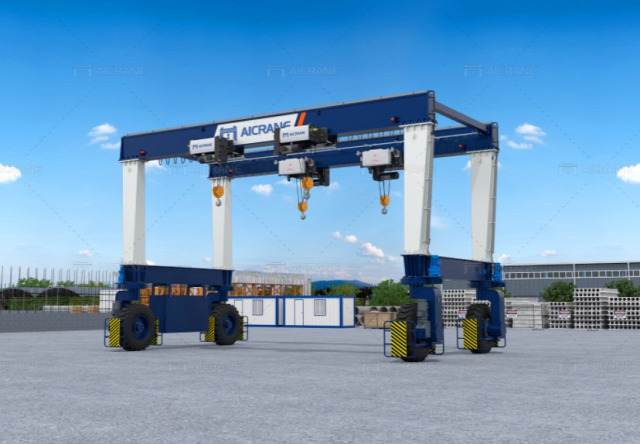Rubber Tyred Gantry Cranes (RTG cranes) are indispensable in a wide range of industries, including container handling, construction, shipyards, and manufacturing. These cranes are lauded for their mobility, flexibility, and high load-handling capacity, making them ideal for moving heavy loads across vast areas without the need for fixed rails. When selecting an RTG crane, one of the most important decisions is choosing between hydraulic and electric-powered systems. Each option has its unique advantages, performance characteristics, and operational considerations. This article delves into the key factors to consider when choosing between hydraulic and electric rubber tyred gantry cranes.

1. Overview of Hydraulic Rubber Tyred Gantry Cranes
Hydraulic rubber tyre gantry cranes use hydraulic systems to power various crane movements, including lifting, lowering, and traveling. The hydraulic system typically consists of a pump, fluid reservoirs, and cylinders that convert hydraulic energy into mechanical force.
Advantages of Hydraulic RTG Cranes
-
Powerful Lifting Capabilities: Hydraulic RTGs are renowned for their immense lifting power, making them well-suited for heavy-duty applications, such as handling large containers, construction materials, and heavy machinery. Hydraulic systems provide continuous power output, allowing them to efficiently lift and move heavy loads without straining.
-
Durability and Robustness: Hydraulic cranes are typically built with fewer moving parts compared to electric cranes, which contributes to their ruggedness and longevity. These cranes can withstand harsh working environments, including extreme weather conditions, making them ideal for industries such as construction and mining.
-
Precise Control: The hydraulic system allows for smooth, precise control of crane movements. Operators can adjust lifting speeds, angles, and movements with fine precision, enabling safe handling of delicate or oversized loads.
-
Independence from Electrical Infrastructure: Hydraulic RTG cranes do not rely on external electrical infrastructure, which makes them highly versatile in remote areas or locations with limited access to power grids. This mobility is particularly valuable for applications in off-the-grid industrial sites, shipyards, and construction zones.

Drawbacks of Hydraulic RTG Cranes
-
Higher Maintenance Requirements: Hydraulic systems, though durable, require regular maintenance to ensure optimal performance. Issues such as fluid leaks, hose wear, and component degradation can lead to downtime if not addressed promptly. Additionally, hydraulic fluids need to be regularly replaced or filtered to maintain system efficiency.
-
Environmental Impact: The use of hydraulic oil and the risk of potential leaks can have environmental consequences, particularly in ecologically sensitive areas. Disposal of hydraulic fluids must be done in an environmentally responsible manner, which adds to operational costs.
-
Higher Initial Costs: Hydraulic RTG cranes tend to have a higher initial capital investment due to the complexity of their systems. The additional cost can be a deciding factor for companies with limited budgets.
2. Overview of Electric Rubber Tyred Gantry Cranes
Electric rubber tyred gantry cranes are powered by electric motors that drive the crane's movements. These cranes are connected to the power grid through cable reels, or they can be equipped with battery-powered systems for enhanced mobility.
Advantages of Electric RTG Cranes
-
Energy Efficiency and Cost Savings: Electric RTG cranes are typically more energy-efficient than their hydraulic counterparts. They consume less energy during operation, which leads to lower operational costs in the long run. Additionally, as industries move toward greener energy solutions, electric RTG cranes can be powered by renewable energy sources, further reducing operational costs and environmental impact.
-
Reduced Environmental Impact: Electric cranes are considered more eco-friendly than hydraulic cranes due to the absence of hydraulic fluid and oil. They produce lower emissions, making them ideal for industries looking to comply with environmental regulations and reduce their carbon footprint.
-
Lower Maintenance Requirements: Electric cranes generally have fewer moving parts and no hydraulic fluid components, resulting in reduced maintenance costs and less frequent servicing. Operators don’t need to worry about fluid leaks, oil changes, or contamination risks, which translates into lower downtime and higher productivity.
-
Quieter Operation: Electric RTG cranes operate more quietly than hydraulic cranes, making them more suitable for urban areas or locations where noise pollution is a concern. The quiet operation contributes to a safer and more comfortable working environment for crane operators and surrounding workers.
Drawbacks of Electric RTG Cranes
-
Dependence on Electrical Infrastructure: Electric RTG cranes require a stable and reliable power source, which can limit their mobility and deployment in remote locations. The need for cable reels or charging stations can also restrict their range of operation.
-
Limited Power for Heavy Lifting: While electric RTG cranes are highly efficient for light to moderate lifting tasks, they may not provide the same level of raw lifting power as hydraulic cranes. In applications requiring consistent heavy-duty lifting, hydraulic systems may still outperform electric systems.
-
Initial Costs for Infrastructure: Implementing an electric RTG crane system may require additional investment in infrastructure, such as power supply upgrades, cable management systems, and battery charging stations. These upfront costs can be a consideration when choosing between electric and hydraulic systems.
3. Key Factors to Consider When Choosing Between Hydraulic and Electric RTG Cranes
1. Application and Load Requirements
The nature of your operation and the type of loads being handled will largely determine which system is best suited to your needs. For industries requiring heavy-duty, continuous lifting, hydraulic RTG cranes may be the better option. However, if your focus is on cost-efficiency, environmental sustainability, and light to moderate lifting tasks, electric RTG cranes offer significant advantages.
2. Environmental Considerations
Electric RTG cranes have a lower environmental impact due to their energy efficiency and the absence of hydraulic fluids. If sustainability is a priority, or if you’re operating in environmentally sensitive areas, electric cranes may be the optimal choice.
3. Maintenance and Downtime
Hydraulic systems require more frequent and specialized maintenance compared to electric systems. Consider the availability of skilled technicians, spare parts, and the potential downtime associated with hydraulic fluid management when making your decision.
4. Mobility and Location
For operations in remote locations with limited electrical infrastructure, hydraulic RTG cranes offer greater flexibility and independence. Conversely, if you have a reliable power source and the infrastructure to support electric RTG cranes, they provide a more energy-efficient and eco-friendly option.
4. Conclusion
Choosing between hydraulic and electric rubber tyred gantry cranes depends on several factors, including load requirements, operational environment, maintenance capacity, and cost considerations. Hydraulic RTG cranes excel in heavy-duty applications, offering immense power and durability, but they require regular maintenance and have a higher environmental impact. Electric RTG cranes are more energy-efficient, cost-effective, and environmentally friendly, making them ideal for industries focused on sustainability and efficiency.
Ultimately, the decision between hydraulic and electric RTG cranes comes down to understanding your specific operational needs, long-term goals, and the environment in which the crane will be used. Both technologies offer unique advantages, and selecting the right option will help you optimize productivity, reduce costs, and achieve your business objectives.

